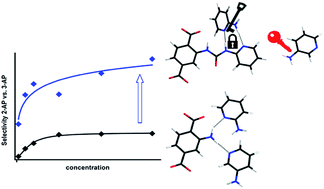Selective host–guest interactions in metal–organic frameworks via multiple hydrogen bond donor–acceptor recognition sites†
Abstract
Targeted recognition of medium sized molecules with mixed hydrogen bond units is essential for using porous materials for molecular separation, sensing and drug delivery. One promising way to achieve selectivity, is to make use of the key-and-lock principle guiding the design of hydrogen bond receptors matching the chemical signature of the target molecules. Among the class of porous materials metal–organic frameworks are particularly well suited for this purpose, as they allow for functionalizing the inner surfaces with various pending groups. Here we report the successful incorporation of 2-pyridyl urea (URPy) side groups with hydrogen bond donor–donor–acceptor (DDA) patterns into the framework MIL-101 with pores in the mesoporous range. Their influence on the sorption properties was investigated by competitive adsorption of 2-aminopyridine (2-AP) and 3-aminopyridine (3-AP) on MIL-101-URPy (Al, Cr) derivatives and comparison to the behaviour of a single donor function within MIL-101-NH2 (Al, Cr) derivatives. Grafting the coordinatively unsaturated sites at the inorganic building units (IBUs) with diethylamine, additionally allowed the adsorption at these sites to be suppressed and thus to focus on the hydrogen bond receptors. Compared to the single D sites the selectivity of 2-AP over 3-AP is enhanced by a factor of five for the DDA pending groups. Based on 15N NMR spectroscopy and DFT calculations this observation is explained by forming double hydrogen bonds between the pyridyl urea groups and the 2-AP molecules, while 3-AP exhibits a single hydrogen bond only. At the D site of MIL-101-NH2 both 2-AP and 3-AP form single hydrogen bonds only.



 Please wait while we load your content...
Please wait while we load your content...